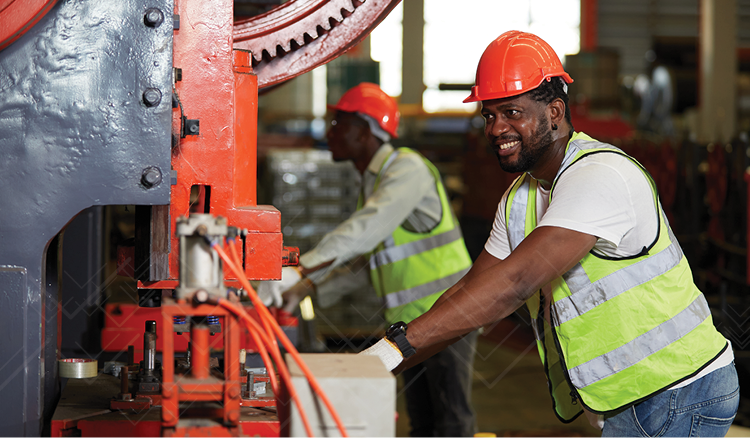The Strategic Shift in Oil & Gas Labor: Game-Changing Strategies Driving Agility & Profit
In The Big Rich: The Rise and Fall of the Greatest Texas Oil Fortunes, Bryan Burrough noted “Success in the oil industry has often hinged on the ability to adapt to changing circumstances and seize new opportunities.” For today’s oil and gas leaders, this adaptability translates into a foundational need for agility—in production, cost management, and quality control. When these pillars are secure, profitability becomes a natural outcome.
Oil and gas companies are on the verge of a significant opportunity for growth, fueled by anticipated regulatory changes and a global demand surge. However, seizing this opportunity demands more than just increasing production. It requires a deep restructuring of labor strategies to support agility and resilience in a sector where shifts in demand are as volatile as the markets themselves.
Yet, current labor strategies in oil and gas equipment manufacturing - dominated by fixed, full-time roles - can be a barrier to this agility. Many firms find themselves with high labor costs even during off-peak periods, impacting profit margins and operational flexibility. In this context, Veryable’s on-demand labor platform offers a compelling path forward, enabling companies to adapt their workforce dynamically in real time, aligning labor directly with demand.
Understanding the New Labor Landscape
Oil and gas manufacturing companies have traditionally operated in a cyclical environment, requiring flexibility in resources, yet the labor model has often remained rigid. This mismatch leads to overstaffing costs during low periods and delays in ramping up during demand spikes. In an industry study published by Harvard Business Review, the researchers found that companies able to dynamically adjust their workforce “were 20-30% more profitable than their competitors in times of peak demand, owing largely to the elimination of unproductive labor costs.”
In “Digital Oilfield: Innovations and New Technologies in Oil and Gas," Bangert notes, “In an industry as variable as oil and gas, labor must be as flexible as capital—otherwise, labor costs alone can stymie growth when times get lean.” In this sector, where demand can shift dramatically in response to market and regulatory changes, a rigid labor model can quickly become a costly liability. By aligning labor costs with real-time demand, companies can avoid the financial strain of carrying excess labor in downturns or scrambling to hire in peak cycles. A flexible, on-demand workforce, therefore, becomes not only a strategic advantage but a necessary measure for sustained growth and resilience in an industry defined by its fluctuations.
The Pitfalls of a Fixed Workforce in a Variable Market
When companies maintain a full-time workforce to handle peak periods, they are left with high fixed costs during lean times, creating inefficiencies that chip away at profit margins. A report from McKinsey & Company highlights that, on average, companies in cyclical industries that rely on fixed labor models spend up to 25% more on labor costs annually than their competitors with flexible labor models.
The financial and operational pitfalls of maintaining a static workforce in a dynamic industry make the case for an adaptable model. Fixed roles that contribute only during peak demand or require layoffs in downturns are ultimately unsustainable.
Embracing On-Demand Labor as a Strategic Solution
Veryable’s on-demand labor model offers a solution that aligns with the KPIs that matter most to oil and gas leaders: production throughput, labor cost efficiency, asset utilization, and precision.
1. Production Throughput
Production throughput, or the rate at which goods move through the production system, is critical in oil and gas. Veryable enables roles like Production Assistants and Machine Operators to be deployed as needed, keeping skilled labor focused on core tasks and ensuring that production lines flow without interruption.
• Impact Example: United Plastics Group (UPG) leveraged Veryable to support scalability in real-time, seeing a notable improvement in throughput. By aligning labor with customer expectations, they not only met demand but exceeded it without carrying excess costs. (case study link)
2. Labor Cost per Unit of Output
For CFOs, labor cost per unit of output directly impacts profit margins. Veryable’s model enables companies to employ roles like Assembly Assistants and Material Handlers only when production requires, ensuring that labor costs are scaled to demand.
• Financial Efficiency Insight: Metal Flow Corporation, which transitioned to a flexible labor model, reported a 15% reduction in labor costs by aligning workforce needs directly with production. This shift not only increased profit margins but safeguarded them during volatile demand cycles. (case study link)
3. Asset Utilization and Equipment ROI
The oil and gas sector is capital-intensive, with equipment investments being among the largest expenses. Asset utilization—the measure of how effectively equipment is used—becomes a crucial KPI. With Veryable operators in roles like Warehouse Technicians and Inventory Control Specialists, companies can reduce equipment downtime and optimize capital investments.
• Real-World Example: RTIC, a leader in cooler manufacturing, used Veryable operators to maintain high equipment utilization during peak demand periods, achieving a 35% increase in utilization. This operational improvement maximized returns on equipment investments and kept production at optimal levels. (case study link)
4. Ensuring Precision and Capacity with Skilled Machinists
Precision is critical in oil and gas, especially as demand increases. Veryable provides access to skilled machinists and production support roles, enabling companies to meet tight production timelines without sacrificing quality.
• Machining Excellence in Action: Mack Tool and Engineering leveraged Veryable’s platform to source skilled machinists during peak production periods, helping them meet output targets with precision. By filling critical machining roles on-demand, Mack Tool was able to increase productivity and ensure product quality—a vital advantage in high-stakes environments. (case study link)
A Strategic Workforce Model for Sustainable Growth
As companies prepare for increased production, they must also prepare for a future where agility is essential. By incorporating on-demand labor through Veryable, oil and gas companies can operate with both flexibility and control, enhancing key metrics like throughput, cost efficiency, and quality.
Successful innovation requires a model that adjusts to reality, not merely to projections. In this sense, Veryable’s on-demand workforce model exemplifies lean, adaptable strategy. It allows oil and gas companies to respond to real-time conditions without the cost burden and rigidity of traditional labor models.
Redefining Resilience in Oil & Gas
The oil and gas industry is on the cusp of transformation, and those who will thrive are the ones willing to rethink the structures that have defined them for decades. A flexible workforce is no longer just a response to temporary demand shifts; it’s a strategy that builds resilience. By adopting Veryable’s on-demand labor model, oil and gas companies can meet current demands and ensure that they are prepared for whatever the future holds.
For industry leaders, this isn’t just about meeting today’s needs. It’s about securing the ability to pivot, to grow, and to maintain control over their operations. In a world where adaptability is the new stability, Veryable is more than a labor solution—it’s a strategic path to long-term success.
To Get Started with Veryable: Create your Company Profile
Information Specific to Your Role: Click Here
Full List of Case Studies: Click Here
Previous Posts
Why Your Operation Isn’t Too Complex or Specialized for On-Demand Labor
The Future of Manufacturing and Logistics
Create a free business profile today to explore our platform.






